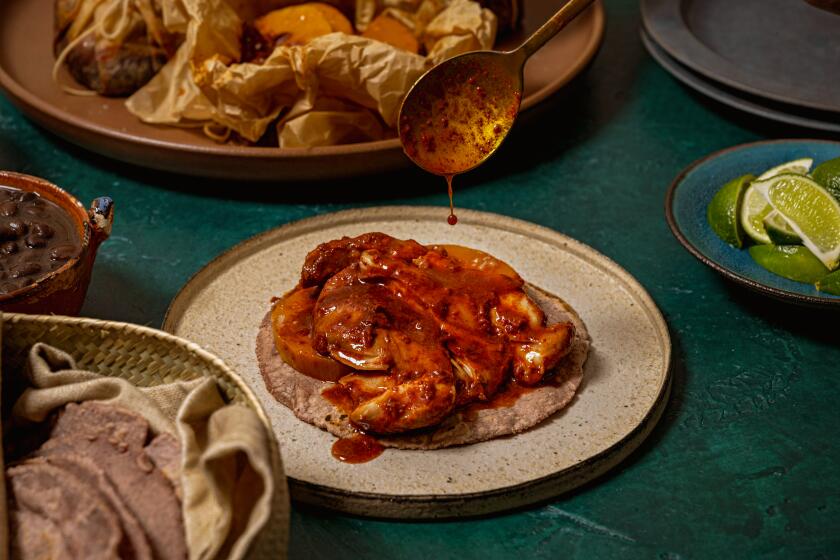Seekh kebab

- Share via
Tomorrow night is the beginning of Eid al-Adha, the Muslim holiday corresponding to the final day of the Mecca pilgrimage. Non-Muslims are probably more familiar with Eid al-Fitr, which ends the Ramadan fast, but Eid al-Adha -- the Feast of the Sacrifice -- is actually the more important celebration. It’s also known as the Great Feast (Eid al-Kabir).
Over the three-day holiday, Muslims around the world gather with family and friends, sitting down to tables laden with special-occasion dishes, turning their thoughts to the pilgrims in Mecca, performing acts of charity and welcoming visitors.
It’s an important food holiday, but the celebratory menu varies widely, with dishes particular to each region on the family tables -- curries in Bangladesh, pilafs in Iran, red-stewed lamb in China, whole roast lamb in Iraq. Since the Muslim calendar is lunar, Muslim holidays don’t fall in the same season every year, so even in the same place, the menu may change from year to year.
With the success of its recent elections, Afghanistan is much in the news lately, so I talked to some Southland Afghans about their Eid al-Adha culinary traditions.
There may not be many of them in this country, but Afghans are proud of their cuisine, and surprisingly often they open restaurants. Relatives of newly elected Afghan President Hamid Karzai run restaurants on the East Coast. It’s an attractive cuisine, a little like Persian and a little like Indian, but with a number of pastas and a distinctive taste for seasoning meat with yogurt.
Zahir Habib, who formerly ran Kabul Cuisine in Reseda, told me that in Afghanistan, as in other countries throughout the Middle East, Eid al-Adha is a time of feasting on meat dishes. “Everybody who can afford it kills a cow or a sheep,” he says. “In Afghanistan they make it in all sorts of ways -- kebab, qorma [stew], soup, which we call shorwa. Lamb shanks, lamb chops, steaks, qabili pilau [pilaf with lamb, carrots and raisins].”
Throughout history, meat has been a luxury ingredient. The abundance of meat served during Eid al-Adha not only connects celebrants with the pilgrims in Mecca, who are sacrificing lambs in memory of Abraham, but is an occasion for charity. Traditionally a portion of the meat should go to the poor. (In the modern world, many Muslims donate money to charity instead of making a physical gift of meat.)
Abdul Karim, owner of Azeen’s Afghani Cuisine in Pasadena, describes another specific food of the holiday in Afghanistan: shul-e goshti, a porridge consisting of rice, beans, chickpeas and meat. “It’s distributed to the poor,” Karim says. “It’s not restaurant food, but it’s very tasty.”
Many Afghan dishes are easily adapted to the American kitchen, but there are few resources for cooks interested in exploring the cuisine. Amazon lists only two Afghan cookbooks, one of which, “Afghan Food & Cookery: Noshe Djan” by Helen Saberi, an Englishwoman married to an Afghan, gave us three excellent recipes appropriate for the holiday, two lamb dishes and a quite traditional cookie.
One is seekh kebab, the Afghan version of shish kebab, subtly aromatic with coriander. It’s served like many other kebabs around the world, with bread, tomatoes and onions, but it’s worth studying its marinade. The lactic acid in the yogurt is a very effective meat tenderizer. The result is tender and appetizingly tangy.
Qorma-e ru-ye nan shows the Afghans’ love of yogurt again, and also their taste for combining it with both leeks and stewed meat. Served on toasted flatbread wedges, this is an appetizing dish with a hearty folk-food quality. It’s almost an Afghan version of nachos. This dish calls for chakka, the Afghan version of yogurt cheese: yogurt that has been drained in cheesecloth for six hours to overnight, which concentrates its flavor.
Festive snacks served to visitors are an important part of Eid al-Adha. Guests are offered fruits, nuts, candies and home-baked cookies. Karim singles out kulcha-e birinj, a wafer-like rice cookie with a pistachio set on top, and ab-e dandon, a cardamom-spiced cookie that’s also described in Saberi’s book. As the name suggests (it literally means “water of the teeth”), these cute button-like cookies crumble and then melt in the mouth, leaving a scent of cardamom, rose water and pistachio.
Afghanistan boasts a unique special-occasion beverage, often served at Eid al-Adha: qaymaq chai. Abdul Karim explains how to make it: First brew a strong pot of green tea. Add half a teaspoon of baking soda, bring it to the boil “until the foam turns pink,” then pour the tea back and forth from one pot to another. Presto -- the tea turns deep, purplish brown. Then you add sugar, cardamom and milk to taste, making something like an Indian chai, but with a distinctive pink color.
That much you could easily make at home. For the final touch, though, Afghans top it with clotted cream (qaymaq), a rich dairy product midway between cream and butter -- some Middle Eastern markets stock it. A poetic Afghani has compared qaymaq chai to the reddish glow of Afghanistan’s mountains at sunset, with the clotted cream standing for their snowcapped peaks.
Mix the lemon juice, garlic, yogurt, oil, salt, pepper and coriander in a large bowl.
Cut the lamb into 1-inch chunks and stir into the lemon juice mixture. Cover the bowl with plastic and marinate 4 hours to overnight.
Put about 5 pieces of lamb on each of 12 metal skewers. Grill 6 to 8 minutes. Serve in lavash or chapati bread garnished with onion, tomatoes and lemon wedges.
Get our Cooking newsletter
Get a taste of Los Angeles — and the world — with recipes and kitchen tricks from the L.A. Times’ Cooking newsletter.
You may occasionally receive promotional content from the Los Angeles Times.















